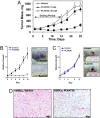Discovery of a selective inhibitor of oncogenic B-Raf kinase with potent antimelanoma activity
- PMID: 18287029
- PMCID: PMC2268581
- DOI: 10.1073/pnas.0711741105
Discovery of a selective inhibitor of oncogenic B-Raf kinase with potent antimelanoma activity
Abstract
BRAF(V600E) is the most frequent oncogenic protein kinase mutation known. Furthermore, inhibitors targeting "active" protein kinases have demonstrated significant utility in the therapeutic repertoire against cancer. Therefore, we pursued the development of specific kinase inhibitors targeting B-Raf, and the V600E allele in particular. By using a structure-guided discovery approach, a potent and selective inhibitor of active B-Raf has been discovered. PLX4720, a 7-azaindole derivative that inhibits B-Raf(V600E) with an IC(50) of 13 nM, defines a class of kinase inhibitor with marked selectivity in both biochemical and cellular assays. PLX4720 preferentially inhibits the active B-Raf(V600E) kinase compared with a broad spectrum of other kinases, and potent cytotoxic effects are also exclusive to cells bearing the V600E allele. Consistent with the high degree of selectivity, ERK phosphorylation is potently inhibited by PLX4720 in B-Raf(V600E)-bearing tumor cell lines but not in cells lacking oncogenic B-Raf. In melanoma models, PLX4720 induces cell cycle arrest and apoptosis exclusively in B-Raf(V600E)-positive cells. In B-Raf(V600E)-dependent tumor xenograft models, orally dosed PLX4720 causes significant tumor growth delays, including tumor regressions, without evidence of toxicity. The work described here represents the entire discovery process, from initial identification through structural and biological studies in animal models to a promising therapeutic for testing in cancer patients bearing B-Raf(V600E)-driven tumors.
Conflict of interest statement
Conflict of interest statement: S.-H.K. and J.S. are Plexxikon founders and share holders.
Figures




Similar articles
-
Targeting BRAFV600E with PLX4720 displays potent antimigratory and anti-invasive activity in preclinical models of human thyroid cancer.Oncologist. 2011;16(3):296-309. doi: 10.1634/theoncologist.2010-0317. Epub 2011 Feb 25. Oncologist. 2011. PMID: 21355020 Free PMC article.
-
Clinical efficacy of a RAF inhibitor needs broad target blockade in BRAF-mutant melanoma.Nature. 2010 Sep 30;467(7315):596-9. doi: 10.1038/nature09454. Nature. 2010. PMID: 20823850 Free PMC article. Clinical Trial.
-
RG7204 (PLX4032), a selective BRAFV600E inhibitor, displays potent antitumor activity in preclinical melanoma models.Cancer Res. 2010 Jul 1;70(13):5518-27. doi: 10.1158/0008-5472.CAN-10-0646. Epub 2010 Jun 15. Cancer Res. 2010. PMID: 20551065
-
PLX-4032, a small-molecule B-Raf inhibitor for the potential treatment of malignant melanoma.Curr Opin Investig Drugs. 2010 Jun;11(6):699-706. Curr Opin Investig Drugs. 2010. PMID: 20496265 Review.
-
Vemurafenib.Recent Results Cancer Res. 2014;201:215-25. doi: 10.1007/978-3-642-54490-3_13. Recent Results Cancer Res. 2014. PMID: 24756795 Review.
Cited by
-
Regulation of RAF protein kinases in ERK signalling.Nat Rev Mol Cell Biol. 2015 May;16(5):281-98. doi: 10.1038/nrm3979. Nat Rev Mol Cell Biol. 2015. PMID: 25907612 Review.
-
Creating novel activated factor XI inhibitors through fragment based lead generation and structure aided drug design.PLoS One. 2015 Jan 28;10(1):e0113705. doi: 10.1371/journal.pone.0113705. eCollection 2015. PLoS One. 2015. PMID: 25629509 Free PMC article.
-
MicroSCALE screening reveals genetic modifiers of therapeutic response in melanoma.Sci Signal. 2012 May 15;5(224):rs4. doi: 10.1126/scisignal.2002612. Sci Signal. 2012. PMID: 22589389 Free PMC article.
-
KRAS as a Key Oncogene in the Clinical Precision Diagnosis and Treatment of Pancreatic Cancer.J Cancer. 2022 Aug 31;13(11):3209-3220. doi: 10.7150/jca.76695. eCollection 2022. J Cancer. 2022. PMID: 36118526 Free PMC article. Review.
-
Insight into molecular dynamics simulation of BRAF(V600E) and potent novel inhibitors for malignant melanoma.Int J Nanomedicine. 2015 Apr 23;10:3131-46. doi: 10.2147/IJN.S80150. eCollection 2015. Int J Nanomedicine. 2015. PMID: 25960652 Free PMC article.
References
-
- Davies H, et al. Mutations of the BRAF gene in human cancer. Nature. 2002;417:949–954. - PubMed
-
- Samowitz WS, et al. Poor survival associated with the BRAF V600E mutation in microsatellite-stable colon cancers. Cancer Res. 2005;65:6063–6069. - PubMed
-
- Riesco-Eizaguirre G, et al. The oncogene BRAFV600E is associated with a high risk of recurrence and less differentiated papillary thyroid carcinoma due to the impairment of Na+/I- targeting to the membrane. Endocr Relat Cancer. 2006;13:257–269. - PubMed
-
- Sawyers C. Targeted cancer therapy. Nature. 2004;432:294–297. - PubMed
Publication types
MeSH terms
Substances
Associated data
- Actions
- Actions
- Actions
- Actions
Grants and funding
LinkOut - more resources
Full Text Sources
Other Literature Sources
Chemical Information
Medical
Molecular Biology Databases
Research Materials
Miscellaneous

